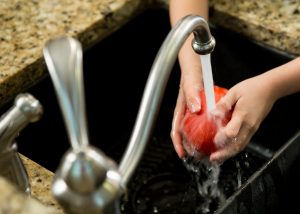On a recent trip to the grocery store, I noticed that the produce section was bursting with fresh produce. I was impressed by the quantity and variety, all the more so since I still couldn’t get the all-important toilet tissue.
Then, it dawned on me that the abundance might be tied to leery consumers purchasing less fresh produce right now. So, I went back to my “new” home office and asked our Extension sustainable agriculture agent. And she confirmed my suspicion: farmers are struggling to sell their produce now.
We all still need to eat nutritiously, and that means fresh fruits and vegetables in our diets. So, let’s review the basic steps for preparing our fresh produce to keep away any pathogens.
- First, start with clean hands. Scrubbing your hands for at least 20 seconds will also reduce the amount of pathogens on your hands prior to you touching the produce.
- Second, make sure you are using a cutting board that is dedicated to fresh fruits and vegetables. You don’t want to cross contaminate!
- Third, don’t wash all the fruits and vegetables when you bring them home. This process will increase the rate of pathogen growth due to the dampness left behind on the product. Instead, wait to wash until you are ready to use. Consider keeping them in their original packaging.
- Fourth, some fruits such as cantaloupe have a rough, netted surface and need to be scrubbed with a brush before you begin to slice. Cantaloupe can harbor pathogens inside the crevices so wash thoroughly. But remember, all fresh fruits and vegetables need to be washed before preparation or consumption.

OK, so how DO you wash produce?
The U.S. Department of Agriculture and federal Centers for Disease Control and Prevention recommend as an effective method: thoroughly rub fruits and vegetables briskly with your hands under cold, running water to remove dirt, garden pests, and pathogens.
A note of caution: don’t wash your fresh produce by immersing it in your kitchen sink. Unless you properly sanitize your sink daily, it will harbor pathogens. If you want to clean your produce by immersing it rather than (or in addition to) using the running-water method noted above, use a clean bowl of fresh water rather than the sink.
I’ve also had some people ask about using white vinegar to clean produce. If you choose this process here is the proper formula:
- Add 1/2 cup of distilled white vinegar to 1 cup of water. This can be used for your leafy greens but may affect the texture and taste. Try separating the leaves and individually placing each into a bowl with the mixture.
- Follow this with a thorough rinsing under cold water.
- Dry the produce using a salad spinner or paper towels.
Last, while I was walking my dog, a neighbor stopped me (yes, we maintained our 6-foot spacing) to ask if it was a good practice to use chemical rinses or even bleach to clean the produce. The U.S. Food and Drug Administration advises against using commercial produce washes because the safety of their residues has not yet been evaluated and their effectiveness has not been tested. And never use bleach to clean produce, since it is not safe to consume!
One more thing: buy local, whenever and wherever you can. Not only does it reduce transport time, which can limit the chances of bacterial growth, but it also helps our local farmers (your neighbords) and our economy.
If you are interested in purchasing bulk amounts from farmers, UF/IFAS Extension Sarasota County is teaming with Transition Sarasota on a project that showcases locally available products. Visit the Transition Sarasota web site for a list of participating growers and contact information. You can purchase a case filled with fruits, vegetables and other products, and pick it up at a convenient dropoff site. Remember, these will be large quantities, so be prepared to cook, bake, can, dehydrate, freeze and of course enjoy fresh!
Look for more sanitizing tips in my next blog.
RESOURCES
Partnership for Food Safety Education, a public-private non-profit collaborative focusing on consumer food safety education, has produced a “Fresh Produce and COVID19” video.
Sarah Bostick is the UF/IFAS Extension Sarasota County Sustainable Agriculture Program agent
 0
0
